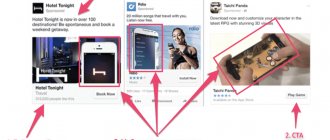Hello! In this article we will talk about the process of determining client needs.
Today you will learn:
- What is a need;
- How to properly build a dialogue with a client in order to identify his needs;
- What types of questions exist and how to use them correctly;
- What mistakes should not be made when determining client needs.
Content
- What is “need”
- Why is it necessary to determine customer needs during the sales process?
- Methods for identifying needs
- How to identify client needs
- 5 Questions to Identify Client Needs
- Listen correctly
- Spend time on the client's needs
- Needs Determination Exercises
- Mistakes in identifying needs
As the number of companies on the market increases, so does the power of the consumer. Screens are full of advertising messages, promoters entice customers with discounts, and supermarkets hold tastings to increase sales. But all your customer acquisition efforts may be in vain if you don't know what your customer wants.
Why is it necessary to identify needs?
Many companies teach you to sell according to needs! But they don’t often explain why. On the one hand, everything is simple, a person decided to buy a TV - his need is a TV, and I will talk about a TV. NO his need for convenience and comfort in receiving information that the TV transmits (movies, programs, TV series, talk shows, sports games, etc.). And if we go deeper, then from all these programs he wants entertainment, emotions, new knowledge. That is, his motivation is much deeper than it seems. And I, as a consumer, will tell you that to watch the news and to watch football, you need completely different TVs. It is in order to help choose the right product that the seller must use the identification of the client’s needs.
This is if you look at it from one side. But besides this, each person is individual in terms of preferences in life, one spends all his money on fashionable things and expensive phones, another saves and saves. And if one is driven by novelty and prestige, then the other is driven by economy. And it would be stupid to offer them the same product.
What is “need”
Identifying customer needs is the second stage of sales, but in fact, you need to think about identifying the needs of the target audience much earlier. But let’s first understand the very concept of “need”.
Need – needs embodied in specific goods and services. This leads to another concept – needs. Unlike needs, needs are innate in nature; these are all those things without which a person cannot continue his life. Need manifests itself in human needs.
Needs are:
- In safety;
- In belonging to any group (class);
- In comfort;
- In reliability;
- In novelty.
In addition, needs can be coupled and uncoupled. Associated need - its satisfaction entails the birth of another need. For example, you bought a blouse, but now you need a skirt to go with it. The consultant’s task is to discover both needs (even before the second one arises) and satisfy them.
As mentioned earlier, identifying needs is the basis of the sales organization. But for the first time, it is necessary to think about what our potential consumers need at the marketing planning stage, that is, marketing, as the process of identifying the needs of the target audience, should come before production (or purchasing, if we own a retail store).
Any business, including yours, should be built around the needs of a specific target audience. Otherwise, you will produce (or purchase) goods that will gather dust on the shelves of a warehouse or store.
Take as a basis the main principle of marketing: “Do not sell what you have produced, but produce what you can definitely sell.” And for this, every decision of an entrepreneur must be supported by marketing research to determine the needs of the target audience.
Now let's talk about the sales process itself.
The entire sales process consists of five stages:
- Search and evaluation of the buyer;
- Determining client needs and establishing contact with him;
- Product presentation;
- Resolving disagreements and objections;
- Conclusion and support of the transaction.
Customers' needs and requirements
Before delving into the technique of identifying client needs , let's figure out what a need is? What are they? Wikipedia comes to the rescue: Need
, need is an internal state of psychological or functional feeling of insufficiency of something, manifests itself depending on situational factors. I like two phrases in this definition: “feelings of insufficiency” and “manifests depending on situational factors.” A need is just a feeling, that is, the value is not constant and needs change depending on the situation. For example, one of my friends traveled to China. While visiting the provinces, he felt like a millionaire despite the poverty that reigned there. But when he arrived in Shanghai, he himself felt like a poor man, seeing a very high standard of living (skyscrapers, expensive cars, etc.). That is, the needs of the same person can change. And if in the first case he did not feel the need for money since he was much richer than his environment, then in the second case he felt the lack of his finances relative to society.
For you and me, all of the above means that we can influence needs. Moreover, we can create them!
Why is it necessary to determine customer needs during the sales process?
In fact, if you have successfully completed the first two stages of the sale, you can be sure that the client will buy your product. At the same time, the process of searching and assessing a buyer should be treated as a preparatory stage before determining the client's needs. Let's find out why correctly identifying needs is so important in the process of selling a product.
First, the client has come to you to solve their problem. The same product can solve completely different problems.
Example. A man wants to buy curtains. The consultant asks the potential buyer about the design of the room for which curtains are being selected, finds out the acceptable price range and demonstrates the best options. But the visitor leaves without purchasing. What is the seller's mistake? The thing is that the consultant did not find out what benefit the client wants to get from the purchase; in other words, he did not identify the client’s problem. We specifically took curtains as an example to show that even the simplest product can solve several problems at once. For example, curtains can have two functions: decorating a room and protecting from the sun. In our example, the consultant was solving the problem of decorating a room, and the client wanted to protect himself from sunlight. This mistake led to the failure of the deal.
Secondly, without knowing the client's needs, you will not be able to fend off his objections, and this is the fourth stage of the sales process. Any customer objection is a doubt that your product can best solve his problem. You must rid him of these doubts, otherwise the client will simply leave you for competitors.
Third, in the personal selling process, it is very important to make it clear to the client that you sincerely want to help solve their problem. This cannot be done without understanding the problem itself.
Examples of problematic issues that shape the client's opinion.
There are questions that will help you sell what you need simply by forming the client’s opinion. It is important to understand that the client does not know a lot and we need to use this to shape his needs. Let me give some examples:
All people complain that clothes are difficult to iron, have you encountered such a problem? – by asking such a question, you will naturally find support from the client. And you can offer him ways to solve this problem. Such problematic questions are very helpful in directing clients' thoughts in the right direction.
Identifying customer problems is very important. You can use questions like: what problems have you encountered? What problems would you like to avoid? What would you like to improve? Once you find out what problems the client is concerned about, you can offer him solutions. In some types of sales, without problem questions there is simply nothing to sell. This type of sales includes active sales and b2b sales.
Methods for identifying needs
And now, the client is already in your store. How to understand what he wants? You need him to tell you about it himself; a better way has not yet been invented.
However, all people are different. Some people happily share their experiences with others, while others remain silent like partisans. An individual approach to building a dialogue should be applied to each client.
This leads to two methods for identifying customer needs:
- Questions;
- Listening.
Both tools must be used in the process of building a dialogue with both an open client and a guerrilla client. But in the first case, we must listen more, and in the second, we must ask.
I would like to immediately draw your attention to the fact that your dialogue with a client, regardless of his belonging to one type or another, should not resemble an interrogation. The consumer's speech should occupy the majority of your dialogue with him. A good salesperson is akin to a good psychologist. The task of these specialists is to identify and solve the client’s problem, and for this it is necessary to bring the “patient” to a frank conversation and listen to him.
Funnel of questions
The first thing any salesperson should know about identifying customer needs is what a question funnel is. Not all coaches teach this term. Although, in my opinion, it is precisely this that fully reflects the essence of identifying the client’s needs.
A question funnel is a sequence of asking questions to determine the client’s needs as accurately as possible. First, you need to ask open-ended questions that will allow you to understand what exactly the client is interested in about the product or service. For example, if you ask:
- Tell us why you bought this particular car?
In response, the person will begin to say what is important to him in the car. And he will not mention anything that is not personally interesting to him. As a rule, from 2 to 5 main characteristics of the product are decisive. But as a rule, the client will only mention 2-3 characteristics in his answer, so you need to ask a few more open-ended questions. This will allow you to create a list of what you will talk about with the client and, most importantly, you will understand what should not be mentioned.
IMPORTANT!!! EXCESSIVE QUESTIONS KEEP YOU AWAY FROM THE SALE, WEIGH THE NEED FOR EACH OF YOUR QUESTIONS.
Once you understand the client’s range of interests, we begin to ask clarifying questions. They can be open-ended, but closed and alternative types of questions are more often used. You shouldn’t ask too many of them; as a rule, asking 10 clarifying questions is enough. Moreover, the less you ask, the more energy you will have to present the product. This applies not only to you, but also to the client. There are times when a client is so tired of discussing a product that there is simply no emotion left to listen about the product.
When all the questions have been asked, you can draw a line by summarizing the identified needs. This will allow you to once again remind the client what you talked about. Show that you heard him and achieve some kind of agreement to what you said.
How to identify client needs
Let's get back to sales. Where to start the conversation?
Let's remember the first stage of the sales process - finding and evaluating a buyer. You should not immediately approach a potential consumer and impose on him a product that he does not need.
Forget about the boring question: “Can I help you with anything?” At the time of your first contact with a client, you should already know how you can help the visitor. To do this, watch him for the first 30-40 seconds, this will allow you to determine the type of product the client came for.
Example. You are a salesperson in a women's clothing store. The visitor pays most attention to formal office-style trousers. Start your dialogue like this: “Good afternoon, my name is Anna. Today in our store there is a new arrival of the office collection, as well as discounts on the old arrival of this line up to 50%. Come along, I’ll show you.”
5 Questions to Identify Client Needs
Once the client has agreed to accept your help, you need to include questions in the dialogue.
Questions come in the following types:
- Closed questions are all those questions that can be answered unambiguously. You should not overuse them, otherwise you will not receive the amount of information that you need. Example: “Do you like dress pants?”
- Open questions are questions that require a detailed answer. But here too there is danger. If the client is not interested in continuing the dialogue, then he will try to quickly escape from the store. Example: “Which pants do you prefer?”
- Alternative questions – these questions already contain several answer options. Example: “Do you prefer tapered or dress pants?”
- Leading questions are necessary when the client is not yet aware of the need. Example: “When choosing trousers, it is very important to determine what time of year you will wear them; if you are buying them for the summer, then light natural materials will suit you, what do you think?”
- Rhetorical questions are atmospheric questions. They serve to maintain a conversation and form friendly relations with the client. “You want your pants to fit you perfectly, right?”
The advantages and disadvantages of each type of question are shown in the table.
| Advantages | Flaws | Tasks | |
| Closed questions | It is easy for the client to answer them | Turn dialogue into interrogation; Provide insufficient information | Obtaining additional information; Obtaining basic information when working with guerrilla clients |
| Open questions | Allows you to obtain the most complete information from the client; Allow the client to talk | They can do a “disservice” and scare off the client; The seller does not always decode the answers correctly, which can cause the client to leave forever; Take a lot of time | Determination of basic need; Start of dialogue |
| Alternative questions | Allows you to obtain sufficient information about the basic need; Not as intrusive as open-ended questions | Prevents the identification of related needs | Determination of basic need; Encouraging the client to take action; End of dialogue |
| Rhetorical questions | Contributes to the formation of a friendly atmosphere | Take up time | Formation of the atmosphere |
| Suggestive questions | Contribute to the formation of needs; Pushed to action | May confuse the client | Formation of need |
In addition to those listed, you can use clarifying questions. This is especially true if you are working with open-ended questions.
As a result, you should receive a certain client questionnaire, which will contain all the necessary information.
Listen correctly
Now I would like to turn our attention to the process of listening. It would seem that there is nothing difficult about listening to a potential client’s answer, but this is not so. If a potential buyer sees your disinterest, then you will lose him forever.
Dialogue is a kind of game with a client in which you must adhere to the following rules:
- Don't interrupt your interlocutor. First, let them speak and only then ask clarifying questions;
- Maintain eye contact. This will allow you to understand the client’s mood regarding the further continuation of the dialogue;
- Give up the idea of questioning the client. If a person does not want to make contact, he is closed, then you should leave him alone;
- Offer options. This will make it possible to interest the client in further continuation of the dialogue, because they really want to help him;
- Keep the conversation going. The main techniques for maintaining a conversation with clients are given in the table.
| Reception | Example |
| Repeating basic information said by the client | As I understand it, you prefer classic trousers |
| Summarizing | So, you need classic blue business style trousers |
| Consequence | So you don't like high-waisted pants? |
| Assent | Nod your head, “hoot” and assent in every possible way during the client’s speech. |
Spend time on the client's needs
When you have suggested a suitable option for trousers, start the dialogue again and offer a product that satisfies the associated first need.
For example, our customer just started a job that requires an office dress code. This means that you can offer her a blouse, jacket and accessories. But you must understand whether your client needs this product while still working to identify and satisfy the first need.
Thus, the process of identifying needs consists of four stages:
- First contact with the client;
- Identifying the problem using questions;
- Listening to the client and offering options;
- Satisfying related needs.
Final task:
Theory is good, but practice sells, so we invite you to do one exercise to practice.
Exercise.
Write 10 questions to clarify the current situation of your buyer
- ……………………………………………….
- ……………………………………………….
- ……………………………………………….
- ……………………………………………….
- ……………………………………………….
- ……………………………………………….
- ……………………………………………….
- ……………………………………………….
- ……………………………………………….
- ……………………………………………….
Write 5 questions about the problems and opportunities your client is facing and missing out on
- ……………………………………………….
- ……………………………………………….
- ……………………………………………….
- ……………………………………………….
- ……………………………………………….
Write 5 questions about pain, i.e. about the consequences that problems lead to
- ……………………………………………….
- ……………………………………………….
- ……………………………………………….
- ……………………………………………….
- ……………………………………………….
Write 5 questions about possible solutions for your client that will give him hope
- ……………………………………………….
- ……………………………………………….
- ……………………………………………….
- ……………………………………………….
- ……………………………………………….
Write 3 questions to offer specific services (alternatives) that will contain solutions to your clients' problems. Give examples of successful cases.
- ……………………………………………….
- ……………………………………………….
- ……………………………………………….
You can learn more about one of the most effective methods for identifying needs in Neil Rackham’s book “SPIN Selling. Practical guide"
Happy sales to you.
The article was prepared based on materials from the “Professional Sales” training.
Needs Determination Exercises
To be confident in your abilities, you need to practice. To do this, gather in a small group (from three people) and play the game “Who am I?”
Its rules are simple: you write the names of famous characters on stickers (literary heroes, famous personalities, cartoon characters) and stick them on each other’s foreheads, so that the one to whom you pasted the sticker does not know the name of which character you wrote.
Then everyone tries to guess whose name is written on their piece of paper. He does this with the help of questions to which the other participants in the game can only answer “yes” or “no.” If the questioner receives a negative answer, then the move is passed to the next participant.
Mistakes in identifying needs
Let's summarize and list the most common mistakes that salespeople make in the process of determining client needs:
- Don't focus on closed questions . If the client does not make contact, then it is better to leave him alone rather than interrogate him;
- You should discover several needs . Always look for related needs, this will allow you to build customer loyalty and double your sales;
- Do not present the product during the needs identification process . You can offer an option, but there is no need to praise it. This will only create the illusion of imposition and lack of choice on the client;
- Be educated . Interrupting a client is the worst mistake a consultant can make when selling and identifying client needs;
- Stick to your goal - selling the product . Don't let the client get sidetracked and turn the sales process into a session with a psychologist. Your task is to solve the client's problem, but only with the help of your product.
Thus, we became familiar with the basic principles of determining client needs in the sales process. These principles apply to both personal and telephone selling.
Identifying needs in the b2b segment
When we identify needs in the b2b segment, we need to find out other aspects from the client.
First, you need to find out the client’s current situation in which he finds himself. As a rule, in the b2b segment, an organization is already working with someone and probably has a current supplier who is currently suitable for it.
In this case, it is as if you are invading a new zone with your new product. This organization will cooperate with you only if it sees any clear benefit for itself in your proposal. This benefit should be aimed at two main points: either your product will allow this organization to increase profits or reduce costs. This is the final component.
We then identify opportunities for improvement, e.g. how this organization can improve the current situation with the help of your product or service. What will be the benefit for her if, for example, she stops working with her current supplier and switches to your products or services.
The next thing that is important to find out is readiness for change. What does this readiness for change include? First of all, the budget. And does the company have a budget to work with you? If this budget is not there, then all your work may be done in vain.
The next point to find out is whether the technological process that is built in this company allows it to also work with your organization? This is also a very important aspect. We must find out the readiness for change in general. Is the company ready to abandon its current supplier in favor of your organization?
The next thing we need to find out is the conditions under which the organization is ready to purchase your product or service.
So, in the B2B segment we are interested in:
- Current situation
- Room for improvement
- Readiness for change
- Terms of cooperation











